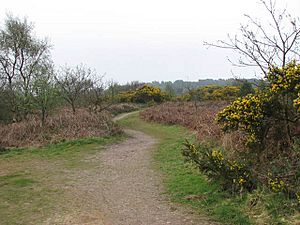Kelling Heath facts for kids
| Site of Special Scientific Interest | |
 |
|
| Area of Search | Norfolk |
|---|---|
| Grid reference | TG 101 418 |
| Interest | Biological |
| Area | 89.4 hectares (221 acres) |
| Notification | 1986 |
| Location map | Magic Map |
Kelling Heath is a very special natural area in Norfolk, England. It covers about 89.4-hectare (221-acre) of land. This heath is located between the towns of Holt and Weybourne. It is so important that it has been named a Site of Special Scientific Interest (SSSI). This means it's a protected area because of its unique plants, animals, or geology. Kelling Heath is also part of the beautiful Norfolk Coast Area of Outstanding Natural Beauty.
Contents
How Kelling Heath Was Formed
Kelling Heath sits on a range of hills called the Cromer Ridge. These hills were created by huge sheets of ice, known as glaciers, during the last Ice age. Imagine giant ice bulldozers pushing and piling up rocks and soil!
Glaciers and Moraines
When the glaciers slowly melted and moved back, they left behind large piles of rock, sand, and clay. These piles are called moraines. Kelling Heath is a great example of a "glacial outwash plain." This is a flat area where water from the melting glaciers spread out sand and gravel. It's one of the best places in England to see how glaciers shaped the land.
Valleys and Slopes
Both Kelling Heath and a nearby area called Salthouse Heath have steep slopes where the ice once touched the land. They also have deep, dry valleys. These features are very important for scientists who study how the Earth's surface changes over time.
Plants and Animals of Kelling Heath
Natural England, a group that protects nature, says Kelling Heath is a wonderful example of "oceanic heathland." This type of open land has special plants that thrive in the coastal weather.
Heathland Plants
The plants here like dry, slightly acidic soil. You'll mostly see different types of heather, like Erica cinerea (bell heather). There's also gorse and ulex gallii (western gorse), which are spiky, yellow-flowered bushes. You might also spot bracken, a type of fern. Some parts of the heath have mixed woodlands too.
Wildlife Living Here
Kelling Heath is home to many interesting birds that nest on the ground. These include the nightjar, which is active at dusk, the whitethroat, and the tree pipit. The dry conditions also make it a perfect home for reptiles. You might see common lizards or even an adder, which is a type of snake.
Visiting Kelling Heath
The North Norfolk Railway actually runs right through Kelling Heath. There's even a small train stop called Kelling Heath Halt. Right next to the heath, there's also a Holiday Park where people can stay and enjoy the beautiful surroundings.

